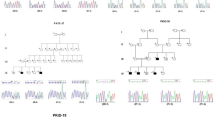Abstract
It was shown that some mutations in a number of zinc finger protein (Znf) genes cause intellectual disability (ID). In our study in two affected siblings with ID exome analysis revealed the homozygous coding sequence (cds) indel rs386809049 in the ZNF527 gene. The c.806_808 deletion CAT and insertion TGTGCA (rs386809049) results in substitution of Pro269 and Tyr270 to Leu, Cys and Asn, located in the interdomain region of Zinc finger protein 527. The analyses of site orthologs revealed that Pro269 and Tyr270 amino acid positions are conserved across mammalian species, indicating that there may be an evolutionarily conserved function. To evaluate the ZNF527 gene involvement in intellectual disability pathogenesis analysis of rs386809049 polymorphism in 300 individuals from general population of Ukraine was performed. The following genotypes distribution was detected: CAT/CAT (67.7%), CAT/TGTGCA (31%) and TGTGCA/TGTGCA (1.3%). As far as we know this is the first published data on rs386809049 distribution in the populations. The ZNF527 TGTGCA (polymorphic) allele frequency was 16.8% and CAT (wild type)—83.2% in the general population of Ukraine. Such a high polymorphic allele frequency allows us to suggest that analyzed rs386809049 polymorphism in ZNF527 gene cannot be the major cause of intellectual disability.
Similar content being viewed by others
References
Urrutia, P.R., KRAB-containing zinc-finger repressor proteins, Genome Biol., 2003, vol. 4, no. 10, p. 231.
Rousseau-Merck, M.F., Koczan, D., Legrand, I., et al., The KOX zinc finger genes: genome wide mapping of 368 ZNF PAC clones with zinc finger gene clusters predominantly in 23 chromosomal loci are confirmed by human sequences annotated in EnsEMBL, Cytogenet. Genome Res., 2002, vol. 98, nos. 2/3, pp. 147–153.
Witzgall, R., O’Leary, E. Leaf, A., et al., The Kruppelassociated box-A (KRAB-A) domain of zinc finger proteins mediates transcriptional repression, Proc. Nat. Acad. Sci. USA, 1994, vol. 91, no. 10, pp. 4514–4518.
Margolin, J.F., Friedman, J.R., Meyer, W.K., et al., Kruppel-associated boxes are potent transcriptional repression domains, Proc. Nat. Acad. Sci. USA, 1994, vol. 91, no. 10, pp. 4509–4513.
Nicolas, E., Poitelon, Y., Chouery, E., et al., CAMOS, a nonprogressive, autosomal recessive, congenital cerebellar ataxia, is caused by a mutant zinc-finger protein, ZNf592, Eur. J. Hum. Genet., 2010, vol. 18, no. 10, pp. 1107–1113.
Shoichet, S.A., Hoffmann, K., Menzel, C., et al., Mutations in the ZNF41 gene are associated with cognitive deficits: identification of a new candidate for X-linked mental retardation, Am. J. Hum. Genet., 2003, vol. 73, no. 6, pp. 1341–1354.
Lugtenberg, D., Yntema, H.G., Banning, M.J., et al., ZNF674: a new Kruppel-associated box-containing zinc-finger gene involved in nonsyndromic X-linked mental retardation, Am. J. Hum. Genet., 2006, vol. 78, no. 2, pp. 265–278.
Tarpey, P.S., Smith, R., Pleasance, E., et al., A systematic, large-scale resequencing screen of X-chromosome coding exons in mental retardation, Nat. Genet., 2009, vol. 41, no. 5, pp. 535–543.
Kleefstra, T., Yntema, H.G., Oudakker, A.R., et al., Zinc finger 81 (ZNF81) mutations associated with X-linked mental retardation, J. Med. Genet., 2004, vol. 41, no. 5, pp. 394–399.
Nagase, T., Nakayama, M., Nakajima, D., et al., Prediction of the coding sequences of unidentified human genes.
The complete sequences of 100 new cDNA clones from brain which code for large proteins in vitro, DNA Res., 2001, vol. 8, no. 2, pp. 85–95.
Gulkovskyi, R.V., Chernushyn, S.Y., Kravchenko, S.A., et al., EPHA1 gene SNPs analysis in population of Ukraine, Biopolym. Cell, 2013, vol. 29, no. 6, pp. 506–510.
Cordell, H.J. and Clayton, D.G., Genetic association studies, Lancet, 2005, vol. 366, no. 9491, pp. 1121–1131.
Balding, D.J., A tutorial on statistical methods for population association studies, Nat. Rev. Genet, 2006, vol. 7, no. 10, pp. 781–791.
Frietze, S., O’Geen, H., Blahnik, K.R., et al., ZNF274 recruits the histone methyltransferase SETDB1 to the 3' ends of ZNF genes, PLoS One, 2010, vol. 5, no. 12, p. e15082.
Author information
Authors and Affiliations
Corresponding author
Additional information
The article is published in the original.
About this article
Cite this article
Gulkovskyi, R.V., Chernushyn, S.Y., Kravchenko, S.A. et al. ZNF527 gene rs386809049 analysis in population of ukraine. Cytol. Genet. 49, 240–244 (2015). https://doi.org/10.3103/S0095452715040040
Received:
Published:
Issue Date:
DOI: https://doi.org/10.3103/S0095452715040040




